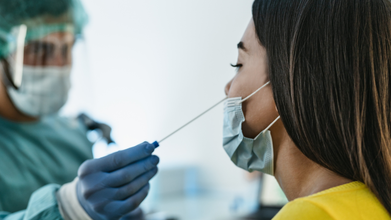- Health Conditions A-Z
- Health & Wellness
- Nutrition
- Fitness
- Health News
- Ayurveda
- Videos
- Medicine A-Z
- Parenting
Can Anxiety Cause Chest Pain? How To Differentiate Between Anxiety Chest Pain And Heart Attack

Chest pains are more common than we think. Many people experience these out of nowhere, no fore warning or previous occurrences etc. Usually having chest pains is associated with heart attacks, which can be fatal. However, did you know, these chest pains could also be due to anxiety?
Panic disorder is a common mental health condition, affecting between 1 and 4 out of every 100 people. If someone experiences repeated anxiety attacks along with ongoing worry or changes in their behavior, they might also have symptoms like chest pain.
In fact, according to the chest pain occurs in 20% to 70% of panic attacks. Interestingly, about 18% to 25% of patients who visit emergency rooms with chest pain actually have panic disorder. This often leads to unnecessary heart tests, and unfortunately, the real cause of their pain goes undiagnosed in many cases.
Why Does Anxiety Cause Chest Pain?
There are several reasons why panic attacks can lead to chest pain, which can be categorized as either heart-related (cardiac) or non-heart-related (non-cardiac). Heart-related chest pain means there's a reduced blood supply to the heart, often due to spasms or a lack of oxygen (ischemia). However, non-heart-related chest pain can come from your muscles, bones, the tube that connects your mouth to your stomach (esophagus), or other organs not connected to your heart.
Non-Cardiac Reasons
Non-cardiac chest pain from anxiety can stem from your muscles and bones, or from your esophagus. Rapid breathing during anxiety, known as hyperventilation, can cause the muscles between your ribs to tense up and spasm, leading to pain. Additionally, anxiety can disrupt how your esophagus moves, causing painful esophageal spasms.
Cardiac Reasons
Anxiety can directly affect your heart, causing pain through various mechanisms. This can include the "fight or flight" response combined with rapid breathing, which may make the blood vessels supplying your heart muscle (coronary arteries) tighten, reducing blood flow. If you already have heart disease, anxiety can also worsen chest pain by making your heart work harder and increasing its oxygen demand. Sometimes, anxiety can even cause the tiny blood vessels in your heart to constrict.
How to Tell the Difference: Anxiety Chest Pain vs. Heart Attack
It can be very challenging to tell the difference between chest pain caused by anxiety and chest pain from a heart attack. However, some symptoms might help you distinguish between the two:
Heart attack chest pain is usually triggered by physical effort, whereas anxiety chest pain can happen even when you're resting.
Heart attack chest pain typically reaches its worst within a few minutes or stays constant; pain due to anxiety might be triggered or made worse by pressing on the painful area.
Anxiety chest pain is often described as sharp and stabbing, felt in a small, specific area. Heart attack pain is usually felt as pressure, fullness, an ache, or a squeezing sensation.
What Can Be Done To Reduce Chest Pains Caused By Anxiety?
If you experience chest pain, it's vital to seek professional medical help immediately. A doctor will accurately diagnose the cause through your medical history and physical exams, ensuring you get the right treatment. Some other ways it can be helped is,
Therapy
Talking therapies, especially Cognitive Behavioral Therapy (CBT), have shown great success in treating anxiety-related chest pain. These approaches help you manage thoughts and behaviors contributing to your anxiety.
Deep Breathing
Once diagnosed, deep breathing can calm your body and mind, helping normalize your heart rate. Inhale for 10 seconds, hold for one, then exhale for 10 to ease the pain.
Calming Techniques
Mind-calming techniques, like focusing on pleasant things, can gradually relieve anxiety symptoms. Remember that anxiety-related chest pain isn't life-threatening; staying optimistic and relaxed can also help.
Keeping Yourself Healthy
Maintaining general health is key. Regular exercise, stress management, adequate sleep, and a balanced diet can prevent future panic attacks. Cutting out caffeine, smoking, and alcohol is also important, as they can worsen anxiety.
Is 2025 The Year Of Flu?

Credits: iStock and Canva
Influenza and other respiratory viruses are surging, note the United Nations. In fact Dr Wenqing Zhang, Unit Head for Global Respiratory Threats at the Department of Epidemic and Pandemic Threats Management of the World Health Organization said that this year is marked by "the emergence and rapid expansion of a new AH3N2 virus subclade". This new variant is called J.2.4.1 or subclade K. This was first reported in August in Australia and New Zealand and has since been detected in over 30 countries.
2025 - A Year Of Flu
Earlier in November, the Public Health Ontario's (PHO) data revealed that Ontario and Canada as a whole could be in a "very tough" flu season this year, thanks to the Influenza A or the flu A. The PHO data revealed a 1.8% rise in influenza cases in the last week of October. Now, amid the influenza A outbreak, 3 children have died from the same in Ottawa and Eastern Ontario region.
US is also facing a flu outbreak and as per the Centers for Disease Control and Prevention (CDC) data, an estimated 2.9 million people have gotten sick so far this season. Among them, 1,200 have also died. This is the 'worst' flu season, point out many experts. For US, the country is seeing a post-Thanksgiving spike in influenza, and saw an 8% increase in people testing positive for the flu.
Super flu or the mutated variant of flu, clade K, has swept the world and caused an early spike in cases worldwide. In Australia, it has caused an early summer spike, while in the UK, it has caused a surge in hospitalization. As per the National Health Service (NHS) England, the number of cases of K flu has been increasing since December 7 and December 11. Hospitalization is up 55% in a week, noted NHS.
Is Flu Shot Effective?
The strain driving the current spike has picked up the nickname “super flu” because it is believed to be a mutated form of influenza A (H3N2), known as “subclade K.”
Influenza H3N2 does not circulate as often as some other flu strains. Dr Simon Clarke, associate professor of cellular microbiology at the University of Reading, explains that the letters “H” and “N” refer to two proteins found on the virus surface, haemagglutinin and neuraminidase. “The numbers simply tell us which versions of those proteins are present,” says Dr Clarke. “It’s a way of grouping strains. This year, H3N2 happens to be the one in the lead.”
“H3 subtypes are relatively uncommon,” he adds. “That means fewer people have built up immunity. There is also evidence they spread more easily and mutate faster, which makes them harder for vaccines to keep up with.
“What we are seeing now is the outcome of that: cases rising sharply earlier than usual, with numbers likely to climb further as winter goes on.”
Recent figures suggest the flu vaccine cuts the risk of hospital admission by roughly 30 to 40 per cent in older adults. That protection rate is lower than for some other vaccines, but it is in line with flu vaccine performance in past years. For that reason, advice has not changed. Vaccination remains the single most effective step people can take to protect themselves and to ease pressure on the NHS.
Super Flu or The K Strain
Known as the superfly, this is H3N2 'subclade K'. It is a type of seasonal influenza A virus and people have not encountered much of it in the recent years. This is why there is less immunity against it. However, the National Health Service (NHS), UK, has already sent out a 'flu jab SOS' to vulnerable people.
NHS has confirmed that the super flu is circulating in England this year, and due to less immunity, it is making it easier to spread across people. The UK Health Security Agency (UKHSA) has urged people to get a flu jab. As per the early data, this year's vaccine has offered good protection despite the new strain.
Daniel Elkeles, chief executive of NHS Providers, said that the major concern is that H3N2 is associated with a more severe illness and superflu could be "a very nasty strain of flu". He said that UK could be experiencing a "tidal wave" of illness.
What Is Influenza A?
As per the National Institutes of Health, US, influenza viruses that contains single-stranded RNA that are classified into three types: A, B, and C. Type A and B cause annual epidemics and even pandemics, while type C is a less common disease.
As per the Centers for Disease Control and Prevention (CDC), Influenza A viruses are descendants of the 2009 H1N1 pandemic virus that emerged in the spring of 2009 and caused a flu pandemic. These viruses, scientifically called the "A(H1N1)pdm09 virus," and more generally called "2009 H1N1," have continued to circulate seasonally since 2009 and have undergone genetic and antigenic changes.
Influenza A(H3N2) viruses also change genetically and antigenically. Influenza A(H3N2) viruses have formed many separate, genetically different clades in recent years that continue to co-circulate.
Not Boarded Any Flight And Still Monday Feels Like A Jetlag? You Are Not Alone

Credits: iStock
It is Monday morning and your alarm rings at 6am. You hit snooze at least twice and feel why weekends are so short. A little bit rewind to two days back, Friday night after work, you did some binge watching and slept till noon on Saturday and again woke up late on Sunday. By evening, you finally felt like a human and again in a few hours, Monday came in. Your body, still confused, groggy, and also a slightly resentful. You feel like you are jetlagged even though you have not even boarded a flight.
This is not laziness or poor discipline, this is social jetlag. Many Indians are living through it. Many of us have two sleep times. One for weekdays and one for the weekends and if you are on a roaster, then your sleeping time adjusts according to your off-days. But the truth is you are not sleeping enough at least for the five days you work and make up for it on your off days. This is what scientists call a social jet lag and it is raising long-term health risks.
What Exactly Is Social Jetlag?
A 2012 study by Till Roenneberg explains that the term 'social jetlag' refers to the mismatch between your biological clock and your social clock. Your biological clock is governed by circadian rhythms, internal processes that decide when you feel sleepy or alert. Your social clock is set by work timings, school schedules, household responsibilities, and social expectations.
Most people sleep earlier and wake up earlier on weekdays because they have to. On weekends, they sleep later and wake up later to recover lost sleep. Researchers describe this as similar to flying across time zones and back every week, except your environment does not change. The sun rises at the same time, but your sleep does not.
Studies suggest that nearly 80 percent of people experience some degree of irregular sleep by shifting sleep times between weekdays and weekends. This pattern has become common due to artificial lighting, late-night screen exposure, and work schedules that are misaligned with natural circadian preferences.
Modern Life Makes It Worse, Here's Why
Artificial light has quietly changed how humans interact with night and day. Evening exposure to bright lights from phones, televisions, and laptops delays the body’s internal clock. This makes it harder to fall asleep early, even when you need to wake up early the next morning.
Over time, this weakens the natural cues that tell the body when it is time to rest and when it is time to be active. Researchers note that this effect creates more late chronotypes, people who naturally feel alert later at night. Unfortunately, most school and office schedules still reward early risers.
The result is a repeated pattern of sleep restriction during weekdays and catch-up sleep on weekends. Unlike travel jetlag, which resolves once the body adjusts to a new light-dark cycle, social jetlag does not correct itself. The solar cycle stays the same, while sleep timing keeps shifting back and forth.
Light is the primary driver of circadian rhythm. In the morning, exposure to sunlight tells the brain to stop producing melatonin, the hormone that makes us sleepy so we feel alert and ready for the day. By evening, melatonin production rises, pushing us toward rest. Night shifts turn this cycle upside down. Instead of winding down, the body is forced to stay active at the very hours it is wired for repair and recovery.
This constant mismatch creates what scientists call 'social jetlag. Your body never gets used to it, because it runs on an internal clock and this is why despite working the same shifts for years, you feel confused.
Indians Are Sleeping Way Less
Data from India paints a worrying picture. A nationwide LocalCircles survey found that 55 percent of Indians get less than six hours of uninterrupted sleep each night. This is an increase from 50 percent the year before, showing that sleep deprivation is getting worse, not better.
Among the reasons cited were late bedtimes combined with early household responsibilities, frequent nighttime awakenings, environmental noise, mosquitoes, and medical conditions like sleep apnea. Even those who spend enough time in bed often experience fragmented sleep.
Wearable sleep data tells a similar story. Fitbit’s global sleep analysis placed Indians as the second most sleep-deprived population after Japan. On average, Indians sleep just over seven hours a night, nearly 50 minutes less than users in the UK and significantly less than Americans. Indians also get the lowest amount of REM sleep globally, a stage critical for memory, emotional regulation, and mental health.
Social jetlag is especially pronounced among adolescents and young adults. Research consistently shows that teenagers naturally shift toward later sleep and wake times due to developmental changes. However, early school start times force them to wake up before their biological clocks are ready.
Late chronotypes accumulate sleep debt during the week and try to repay it on weekends. This pattern has been linked to higher body mass index, metabolic issues, daytime sleepiness, and poorer academic performance. Living against the clock, researchers suggest, may be quietly contributing to the rising burden of obesity and mental health concerns.
In India, academic pressure, coaching classes, screen use, and reduced parental control over sleep schedules only amplify this misalignment.
Social Jet Lag Is Not Just About Feeling Tired, It Has Grave Health Impact
Hormones take the first hit. Our body gets confused on how to regulate melatonin, which is a sleep hormone and cortisol, which is the wake up hormone. It also reduces appetite suppressing hormone leptin, while turning up the hunger hormone ghrelin. This is why you feel the midnight munchies. Chronic sleep deprivation could also lead to prediabetics, as increasing sugar cravings make it difficult for people to prioritize healthy eating.
Studies have associated it with increased risks of obesity, metabolic syndrome, and mental health disorders. It has also been linked to lower productivity, reduced concentration, and mood disturbances.
Addressing social jetlag requires more than sleep tips. Experts suggest later school start times, flexible work hours, reduced evening light exposure, and greater awareness of circadian health. Small changes, like maintaining similar sleep timings on weekdays and weekends, can help, but they cannot fully solve a systemic problem.
Until then, millions of Indians will continue waking up exhausted, wondering why rest feels so elusive.
Covid Symptoms Still Showing Up? Researchers Suggest Other Pathogens May Play A Role

Credits: iStock
COVID symptoms still there? For many people, long COVID is a reality. They continue to live with symptoms like breathlessness, fatigue, and brain fog. To understand this better and why does this continue to persist, a team of microbiologists now have uncovered an important clue. The findings are published in eLife. The researchers suggest that co-infections acquired before or during the bout of COVID could lead to these long-lasting symptoms.
These additional infections have occurred alongside the SARS-CoV-2 and have continued to stay. Maria Laura Gennaro, a microbiologist at Rutgers New Jersey Medical School says, "This is an aspect of long COVID that is not talked about a lot," on the impact of other pathogens on continuous COVID symptoms.
Long COVID Affects Millions
Long COVID has affected around 400 million people from around the world and it has created problems from mild disruptions to severe disability. The research suggests that it can impact the brain, heart, lungs, and even the digestive system.
The new review pulls together existing research and expert insights to spotlight a factor that has largely flown under the radar: infections other than the coronavirus itself may be playing a significant role.
Also Read: Flu Vs Covid: This ONE Key Symptom Will Help You Tell Them Apart, According To Doctor
Other Pathogens That Impact Long Covid
A growing body of evidence points to the Epstein-Barr virus (EBV), best known for causing mononucleosis. Nearly 95 percent of adults carry EBV in a dormant state, where it usually stays quiet unless the immune system is stressed. Infections like COVID can trigger its reactivation.
An early study found that about two-thirds of people with long COVID showed signs of recent EBV activity, with higher antibody levels seen in those reporting more severe symptoms. Later research has linked EBV reactivation to common long COVID complaints, such as persistent fatigue and brain fog.
Another infection drawing attention is tuberculosis, or TB. Around one in four people worldwide carry latent TB. Some evidence suggests that COVID can reduce the immune cells that normally keep TB in check, increasing the chances of reactivation. The link may also run both ways, as TB has been shown to worsen COVID outcomes in some cases.
Researchers stress that timing matters. Infections that occur before COVID may already weaken the immune system. Those that happen during the initial illness could add to tissue damage. Infections that emerge after recovery may take advantage of the immune disruption that COVID leaves behind.
Rising Infections and the Idea of “Immunity Theft”
The authors note that 44 countries have reported tenfold increases in at least 13 infectious diseases compared with pre-pandemic levels. They discuss a concept known as immunity theft, which suggests that an acute COVID infection may leave people more vulnerable to other infections.
If co-infections are found to play a role in long COVID, existing treatments could offer some help. Antibiotics and antivirals already in use might be repurposed to target specific infections. Clinical trials could then test whether treating these infections eases long COVID symptoms.
A Hypothesis Still Under Review
The researchers are careful to point out that this idea is still at an early stage. While the links they describe make biological sense, they have not been proven. No direct cause-and-effect relationship has yet been established between any co-infection and long COVID.
As one researcher put it, correlation does not equal causation. Proving the theory would require large population studies and animal research, which is challenging due to the lack of reliable animal models for long COVID.
© 2024 Bennett, Coleman & Company Limited

